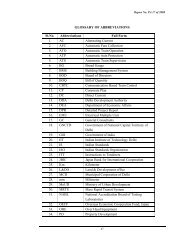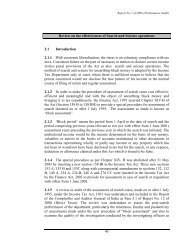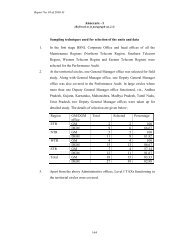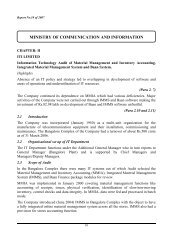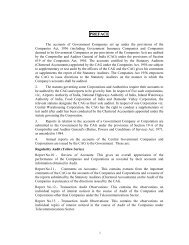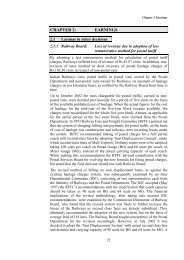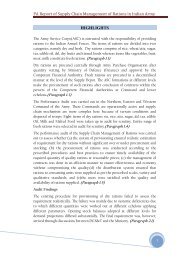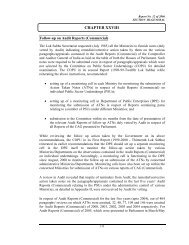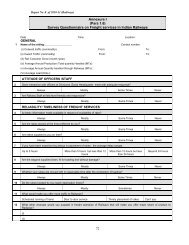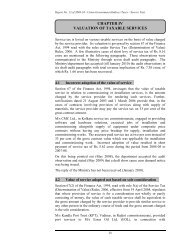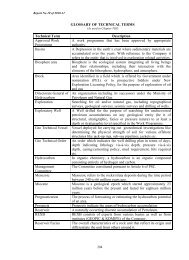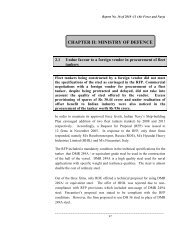Transaction Audit - Comptroller and Auditor General of India
Transaction Audit - Comptroller and Auditor General of India
Transaction Audit - Comptroller and Auditor General of India
You also want an ePaper? Increase the reach of your titles
YUMPU automatically turns print PDFs into web optimized ePapers that Google loves.
Chapter IV – <strong>Transaction</strong> <strong>Audit</strong>The Government stated (November 2004) that validation controls provided in thepackage had to be removed following widespread problems in data <strong>and</strong> plans toimprove the existing databases in Corporations <strong>and</strong> Vellanad Grama Panchayathave been prepared.Disbursement module in “Sevana”Absence <strong>of</strong> provisionto prevent selection <strong>of</strong>ineligible applicantsThe Disbursement module was intended to select beneficiaries <strong>and</strong> disbursepension under different schemes <strong>and</strong> the unemployment dole. Minimum age <strong>and</strong>income <strong>of</strong> the applicant were the parameters for deciding the eligibility for certainpensions such as Old Age Pension, Agriculture Workers Pension etc. Test dataentry made by audit to assess the performance <strong>of</strong> the application revealed thatapplicants with age <strong>of</strong> 22 years <strong>and</strong> the family income exceeding Rs 50,000 wereallowed to be saved to the database for Old Age Pension.Age <strong>and</strong> the documents submitted in support <strong>of</strong> age were unavoidable informationwithout which an application for pension could not be processed. The record wassaved even if the field ‘documents submitted in support <strong>of</strong> age’ was blank. Otherimportant fields such as Pension No., Date <strong>of</strong> disbursement etc., were also blankin many records due to absence <strong>of</strong> validation control.The Government stated(November 2004) that it was not possible to providevalidation control for pension module as pension schemes were originally h<strong>and</strong>ledby various Departments <strong>and</strong> steps have been taken to overcome the limitations <strong>of</strong>the legacy data. As the objective <strong>of</strong> <strong>of</strong>fice automation was to eliminate suchirregularities <strong>and</strong> to ensure transparency <strong>and</strong> accuracy, it was essential to providevalidation controls to prevent selection <strong>of</strong> ineligible beneficiaries.The Pr<strong>of</strong>ession tax module in “Sanchaya”No provision tocapture date <strong>of</strong>service <strong>of</strong> dem<strong>and</strong>noticeNo provision t<strong>of</strong>ollow up dem<strong>and</strong>The pr<strong>of</strong>ession tax module had no provision for (i) initiating penal action underSection 205 K <strong>of</strong> Kerala Panchayat Raj Act 1994 for non-payment <strong>of</strong> tax byEmployer/Head <strong>of</strong> Office, (ii) capturing the date <strong>of</strong> service <strong>of</strong> dem<strong>and</strong> notice, duedate <strong>of</strong> remittance etc., which were essential for taking further action on dem<strong>and</strong>not remitted (iii) follow up action on LPC in the case <strong>of</strong> transfer <strong>of</strong> employees(iv) accounting <strong>of</strong> penalty/fine recovered for belated payment(v) watching/initiating revenue recovery steps for collection <strong>of</strong> arrears in dem<strong>and</strong>.Government stated (January 2004) that necessary provision would beincorporated while integrating Sanchaya with Soochika in the next version <strong>of</strong> thes<strong>of</strong>tware.4.1.11 Absence <strong>of</strong> online transaction in Vellanad Grama PanchayatOnline transactionnot implementedVellanad Grama Panchayat was one <strong>of</strong> the 5 Panchayats selected for Pilot-roll out<strong>of</strong> Plan Monitoring System. IKM installed one computer at the Panchayat on 24November 2000 for the purpose. Five computers <strong>and</strong> one server provided by onelocal entrepreneur were installed on 13 January 2003. The Panchayat wasdeclared as the first fully computerized Grama Panchayat on 25 January 2003.43
<strong>Audit</strong> Report(LSGIs) for the year ended 31 March 2004Though the s<strong>of</strong>tware Sevana, Sulekha, Soochika, <strong>and</strong> Sanchaya, were installed inthe server, no transaction was done through computers online.The Government stated (November 2004) that online operation <strong>of</strong> Soochika <strong>and</strong>Sevana had commenced. But online operation <strong>of</strong> Sulekha, Sanchaya <strong>and</strong> Samkhyais yet to start.4.1.12 Non-involvement <strong>of</strong> staff <strong>and</strong> inadequate security controlsMissing log <strong>of</strong>f details<strong>of</strong> system accessThe s<strong>of</strong>tware-Soochika installed for workflow automation, included a module formarking attendance by staff by logging in <strong>and</strong> logging out <strong>of</strong> the System. Thestaff were, however, not regular in marking attendance. As per the databasedifferent persons had logged on to the system 683 times between 12 August 2002<strong>and</strong> 18 June 2003. But log out details were missing in 415 records. While user IDwas not allotted to two persons currently working, five non-employees had loggedon to the system. Data entry relating to Pr<strong>of</strong>ession tax, collection <strong>of</strong> licence fees,pension disbursement was not current. IKM had been periodically updating thedatabase on back data entry mode by engaging daily wage staff instead <strong>of</strong>utilising the services <strong>of</strong> Panchayat staff for current data entry.Due to inadequate controls for authorizing <strong>and</strong> capturing system access logs, thesecurity <strong>of</strong> the system cannot be vouchsafed.The Government stated (November 2004) that Panchayat has taken steps toresolve inadequacies in marking <strong>of</strong> attendance by staff. It was also stated that theresponsibility for updating data had been entrusted to Panchayat staff.4.1.13 Defective maintenance <strong>of</strong> databaseAnalysis <strong>of</strong> electronic data kept in the server at Janasevanakendram at Vellanadrevealed that the database contained several impurities as discussed below.(i) Many fields such as date, name, place etc vital for generation <strong>of</strong> birth <strong>and</strong>death certificates were blank.(ii) The Building Master table relating to property tax included 1423 housesunder non-existent ward No.15, for which neither house numbers were assignednor assessment particulars were available. The table containing 84809 records <strong>of</strong>Building tax assessment from 1993-94, first half onwards, included 58448uncollected dem<strong>and</strong>s amounting to Rs 19,36,076 whereas the uncollected dem<strong>and</strong>as per details furnished by the Secretary was Rs 4,89,545 only. Thus thedatabase relating to assessee <strong>and</strong> dem<strong>and</strong> was not accurate <strong>and</strong> reliable.(iii) Employee Master table relating to Pr<strong>of</strong>ession tax assessment contained2117 records <strong>of</strong> which the vital fields such as transfer in date, transfer out date,date <strong>of</strong> relief <strong>and</strong> date <strong>of</strong> joining were blank in most <strong>of</strong> the cases. Due to omissionto capture these vital data, any dem<strong>and</strong> raised or dem<strong>and</strong> collection <strong>and</strong> balance(DCB) prepared may not be accurate. Rs 8.5 lakh spent on data entry remainedunfruitful due to non-completion <strong>of</strong> validation process even after one year.44
Chapter IV – <strong>Transaction</strong> <strong>Audit</strong>The Government stated (November 2004) that the Panchayat had been requestedto initiate a process for correction <strong>of</strong> the data.4.1.14 Ineffective computerisation in Urban Local bodiesComputerisation <strong>of</strong>Municipalcorporations behindscheduleS<strong>of</strong>tware applicationsyet to be installedCertificates issuedafter verification <strong>of</strong>manual recordsComputerisation <strong>of</strong> Kozhikode Corporation estimated to cost Rs 70.71 lakh wasentrusted to IKM in March 2001 stipulating the period <strong>of</strong> completion as ninemonths. Though Janasevanakendram ♠ comprising <strong>of</strong> eight counters startedfunctioning from January 2003, only the cash collection other than fee wascomputerised.The Kochi Corporation entrusted (June 2002) the computerisation <strong>of</strong> allfunctional areas to IKM. The project costing Rs 1.33 crore was to be completedwithin one year. But apart from the setting up <strong>of</strong> Janasevanakendram in January2003 for issue <strong>of</strong> birth/death <strong>and</strong> marriage certificates using Sevana, no others<strong>of</strong>tware had been installed for online transaction. IKM did not fulfill itsobligation to supply s<strong>of</strong>tware relating to Plan Monitoring (Sulekha), RevenueModule (Sanchaya) to the Corporations. The s<strong>of</strong>tware for disbursement <strong>of</strong>services - Sevana did not include the module for Pension disbursement. The birth<strong>and</strong> death registration at Kochi covered only four out <strong>of</strong> seven Zones <strong>of</strong> theCorporation. Certificates were issued on the same day, only if the data incomputer matched the details in manual record. In Kozhikode Corporation, therewas delay <strong>of</strong> three days in issuing birth <strong>and</strong> death certificates as the certificateswere to be verified with the original records. Thus in both the Corporations, thedatabases were not reliable.In Kozhikode, Property tax <strong>and</strong> other taxes were collected at the counter usings<strong>of</strong>tware supplied by IKM. In the absence <strong>of</strong> database relating to assessee underthe different sources <strong>of</strong> Revenue, the details <strong>of</strong> collection could not be updated inthe ledger. Revenue collection by Bill Collectors was remitted in bulk at thecounter but the details <strong>of</strong> assessees were not captured. The present system wouldonly help to compile the collection <strong>of</strong> revenue on a particular day as IKM had notinstalled the s<strong>of</strong>tware Sanchaya for revenue collection till date (April 2004).The Government stated (November 2004) that Sulekha s<strong>of</strong>tware has beensupplied to all Corporations <strong>and</strong> the system <strong>of</strong> maintenance <strong>of</strong> stock <strong>of</strong> preprintedstationery had been put in place. But obligation on the part <strong>of</strong> IKM to installSanchaya <strong>and</strong> Sevana (Pension Module) has not been fulfilled so far.4.1.15 Improper maintenance <strong>of</strong> database on birth/death/marriageAnalysis <strong>of</strong> the electronic data kept in the server at Janasevanakendrams, Kochi<strong>and</strong> Kozhikode Corporations revealed the following:In the data relating to birth at Kozhikode (306464 cases) <strong>and</strong> Kochi (196756cases) Corporations, the vital fields such as date <strong>of</strong> birth (128 cases), reporting♠ Public service centre45
<strong>Audit</strong> Report(LSGIs) for the year ended 31 March 2004date (303 cases), sex <strong>of</strong> child (312 cases), registration date (188 cases) <strong>and</strong> child’smother’s name (158 cases) were blank. The fields-date <strong>of</strong> birth <strong>and</strong> reporting dateincluded future dates in 70 cases. There were 1723 pairs <strong>of</strong> duplicate records. In2808 cases the date <strong>of</strong> registration was before the date <strong>of</strong> birth.In the data relating to death in Kozhikode (67058 cases) <strong>and</strong> Kochi (67166 cases)Corporations the fields such as date <strong>of</strong> death (294 cases), registration date (359cases), reporting date (359 cases), name <strong>of</strong> dead person (538 cases) etc wereblank. The date <strong>of</strong> death included future dates in 64 cases <strong>and</strong> date <strong>of</strong> registrationwas before the date <strong>of</strong> death in 1008 cases. There were 125 pairs <strong>of</strong> duplicaterecords.In respect <strong>of</strong> marriage data in Kozhikode (4651 cases) <strong>and</strong> Kochi (3310 cases)Corporations the vital fields such as registration date (115 cases), marriagereporting date (3111 cases), name <strong>of</strong> bride <strong>and</strong> bride groom (193 cases) place <strong>of</strong>marriage (682 cases) were blank. Date <strong>of</strong> marriage was after date <strong>of</strong> registrationin 540 cases.The Government stated (November 2004) that the improper maintenance <strong>of</strong>database was due to poor verification <strong>of</strong> records by Corporation staff <strong>and</strong> theprocess <strong>of</strong> verification by IKM was in an advance stage. The process <strong>of</strong> 100per cent verification which was to be completed before commencement <strong>of</strong>Janasevanakendram in January 2003 is yet to be completed <strong>and</strong> hence theCorporation had resorted to manual verification <strong>of</strong> registration data defeating thevery purpose <strong>of</strong> computerization.4.2 Erroneous computation <strong>of</strong> rate for earth fillingPayment for earth filling with contractors’ own earth at erroneous ratesresulted in excess payment <strong>of</strong> Rs 40 lakh.The Kerala Panchayat Raj (Execution <strong>of</strong> Public Works) Rules 1997 <strong>and</strong> theKerala Municipality (Execution <strong>of</strong> Public Works <strong>and</strong> purchase <strong>of</strong> materials) Rules1997 prescribe the procedures for execution <strong>of</strong> public works by Local SelfGovernment Institutions (LSGIs). The Rules provide that LSGIs shall followprocedures applicable to the Public Works Department (PWD) in the case <strong>of</strong>matters not specified in these rules.The rate for ‘earth work filling with contractors’ own earth’ is arrived at byclubbing the rate for two components, namely, earth work excavation in ordinarysoil <strong>and</strong> conveyance <strong>of</strong> the earth by lorry as provided in the St<strong>and</strong>ard Data Book<strong>and</strong> Schedule <strong>of</strong> Rate respectively. The rate for earthwork excavation in ordinarysoil, includes one lead <strong>and</strong> one lift. The rate for conveyance <strong>of</strong> earth by lorry alsoincludes one lead <strong>and</strong> one lift at loading <strong>and</strong> unloading points. The ChiefTechnical Examiner Finance Inspection Wing, had instructed (April 1986/May2004) that when the item ‘earth work excavation’ was clubbed in the item‘conveyance by lorry’, the labour for one lead <strong>and</strong> one lift should be deducted46
Chapter IV – <strong>Transaction</strong> <strong>Audit</strong>from the combined rate for arriving at the rate for ‘ earth work filling withcontractors own earth’. While clubbing the two rates for computing the rate for‘earth work filling with contractor’s own earth’, rate for one lead <strong>and</strong> one liftwhich stood included in both the components was to be deducted.Test check <strong>of</strong> 124 earth works executed by 11 LSGIs (Appendix VII) during1999-2004 revealed that in works involving earth filling, the rate was erroneouslycomputed without deducting one lead <strong>and</strong> one lift included in both thecomponents. Besides, in certain cases, cost <strong>of</strong> earth instead <strong>of</strong> rate for excavationin ordinary soil was also reckoned. The erroneous computation <strong>of</strong> rate for earthfilling over a period <strong>of</strong> years indicated that the technical scrutiny <strong>of</strong> the estimateby the expert committees <strong>of</strong> the LSGIs was inadequate, leading to excess payment<strong>of</strong> Rs 40 lakh during February 1998 to February 2004.The matter was referred to Government in June 2004; reply had not been received(November 2004).4.3 Irregularity in purchase <strong>of</strong> an incineratorKayamkulam Municipality rejected the lowest <strong>of</strong>fer <strong>of</strong> a State GovernmentUndertaking for supply <strong>and</strong> erection <strong>of</strong> an incinerator <strong>and</strong> placed orderswith a private firm. The firm received Rs 21.50 lakh as advance but failed tosupply the incinerator.In response to a tender (January 2003) for the supply <strong>and</strong> erection <strong>of</strong> anincinerator, Kayamkulam Municipality received four <strong>of</strong>fers. Of these, the lowestwas from a State Government Undertaking for Rs 25 lakh excluding sales tax.The Municipality considered the second lowest <strong>of</strong>fer <strong>of</strong> Rs 48 lakh including salestax from a private firm ‘A’ <strong>and</strong> accepted their negotiated <strong>of</strong>fer <strong>of</strong> Rs 43 lakhagainst the project cost <strong>of</strong> Rs 30 lakh approved by the District PlanningCommittee. The Municipality paid (March 2003) as advance Rs 21.50 lakh t<strong>of</strong>irm ‘A’. The firm had not supplied the plant as <strong>of</strong> October 2004 even though thestipulated time for completion <strong>of</strong> supply <strong>and</strong> erection expired in June 2003.The Municipality stated (July 2003) that the matter was investigated by the JointDirector <strong>of</strong> Urban affairs who submitted his report in August 2003 <strong>and</strong> the resultswere awaited (November 2004).The matter was referred to Government in June 2004; reply had not been received(November 2004).47
<strong>Audit</strong> Report(LSGIs) for the year ended 31 March 20044.4 Unproductive expenditure on a slaughter houseSelection <strong>of</strong> inaccessible site for construction <strong>of</strong> a slaughter house resulted inunproductive expenditure <strong>of</strong> Rs 36.49 lakh.The Thrissur District Panchayat decided (September 1997) to construct aslaughter house at Vellangalloor at an estimated cost <strong>of</strong> Rs 40.82 lakh to makeavailable clean <strong>and</strong> hygienic meat at reasonable rates to the public with the cooperation<strong>of</strong> the Vellangalloor Grama Panchayat. The District Panchayat was toconstruct the slaughter house (Rs 33.19 lakh) <strong>and</strong> the Grama Panchayat topurchase the l<strong>and</strong> (Rs 7.63 lakh). The Grama Panchayat was to run the slaughterhouse after its commissioning.Government issued (October 1998) orders for the transfer <strong>of</strong> 66 cents <strong>of</strong>Poramboke * l<strong>and</strong> at the specified site to the Grama Panchayat with effect from thedate <strong>of</strong> remittance <strong>of</strong> the cost <strong>of</strong> l<strong>and</strong>. The Vellangalloor Grama Panchayatremitted (December 1998) Rs 3.30 lakh from Own Fund <strong>and</strong> took possession(January 1999) <strong>of</strong> the site. There was, however, no proper access from the road tothe site. The District Panchayat paid (June 1998) Rs 33.19 lakh from Plan fund toM/s Steel Industrials Limited, Kerala (SILK), a Public sector Company forconstruction <strong>of</strong> the slaughter house on turnkey basis stipulating the period <strong>of</strong>completion as nine months from the date <strong>of</strong> h<strong>and</strong>ing over <strong>of</strong> the site. The SILKtransported the materials for construction through a private l<strong>and</strong>. On completion<strong>of</strong> the slaughter house in September 2000, when the Grama Panchayat applied forelectric connection, the Kerala State Electricity Board expressed their inability toprovide power connection as the over head cable lines to be drawn had to crossprivate property. The attempts <strong>of</strong> the Grama Panchayat to purchase unencumberedl<strong>and</strong> for an approach road to the slaughter house had not materialised as <strong>of</strong> May2004.Failure <strong>of</strong> the Grama Panchayat <strong>and</strong> <strong>of</strong> the District Panchayat to assess thesuitability <strong>of</strong> l<strong>and</strong> before acquisition resulted in non-completion <strong>of</strong> the projecteven after seven years <strong>of</strong> its commencement <strong>and</strong> in unproductive expenditure <strong>of</strong>Rs 36.49 lakh.The matter was referred to Government in July 2004; reply had not been received(November 2004).4.5 Unfruitful expenditure on clinical laboratoriesPurchase <strong>of</strong> equipment <strong>and</strong> chemicals without creating infrastructurefacilities rendered the expenditure <strong>of</strong> Rs 22.64 lakh unfruitful.The Thrissur District Panchayat approved (August 2001) the project‘Employment for Women in Paramedical Field’ with the objective <strong>of</strong> providing* Unassessed l<strong>and</strong>s which are the property <strong>of</strong> Government or used/reserved for public purposes.48
Chapter IV – <strong>Transaction</strong> <strong>Audit</strong>laboratory services at affordable cost <strong>and</strong> generating employment for women. Theproject envisaged setting up <strong>of</strong> clinical laboratories in Primary Health Centres(PHCs) in 52 Grama Panchayats at a total cost <strong>of</strong> Rs 31.20 lakh. This includes Rs26 lakh for purchase <strong>of</strong> equipments <strong>and</strong> chemicals <strong>and</strong> Rs 5.20 lakh for creatinginfrastructure facilities. The laboratories were to start functioning in December2001.The Implementing Officer placed (August 2002) orders for supply <strong>of</strong> equipments<strong>and</strong> chemicals for 46 laboratories with a local firm without ensuring provision <strong>of</strong>infrastructure facilities at the PHCs. He obtained an invoice from the supplier,certified receipt <strong>of</strong> the materials in good condition, recorded entries in the stockregisters <strong>and</strong> made payment <strong>of</strong> Rs 22.64 lakh (between January – March 2003)but kept the items in the premises <strong>of</strong> the supplier. The Implementing Officerstarted lifting the goods for delivery to PHCs after the expiry <strong>of</strong> 14 months fromthe date <strong>of</strong> supply. He made distribution (between March – July 2004) <strong>of</strong>equipment <strong>and</strong> chemicals to 19 PHCs even though infrastructure was not ready in11 PHCs.The guarantee period <strong>of</strong> two years on equipments <strong>and</strong> chemicals expired inDecember 2004 even though 27 PHCs (out <strong>of</strong> which infrastructure was not readyin 22) were yet to receive the supply. The District Panchayat did not appointlaboratory technicians in any <strong>of</strong> the PHCs.Failure to synchronize purchase <strong>of</strong> equipments <strong>and</strong> chemicals with completion <strong>of</strong>the infrastructure facilities rendered expenditure <strong>of</strong> Rs 22.64 lakh unfruitful. As aresult, the objective <strong>of</strong> providing employment to women in paramedical field <strong>and</strong>extension <strong>of</strong> laboratory services at affordable costs to rural population remainedillusory.The matter was referred to Government in June 2004; reply has not beenreceived(December 2004).4.6 Idle investment on establishment <strong>of</strong> blood banksInvestment <strong>of</strong> Rs 20.28 lakh made during 1997-2002 for creation <strong>of</strong> bloodbanks remained unproductive as Local Self Government Institutions failed toprovide requisite infrastructure for the blood banks.Local Self Government Institutions (LSGIs) formulated projects for establishment<strong>of</strong> blood banks during 1997-2001. As per the project report, the LSGIs were toconstruct buildings, procure necessary equipment, secure m<strong>and</strong>atory licencesfrom Drugs Controller, appoint required staff <strong>and</strong> provide other infrastructurefacilities like water supply, electricity etc. Test-check <strong>of</strong> the accounts <strong>of</strong> fourLSGIs disclosed that Rs 20.28 lakh spent during 1997-2002 on construction <strong>of</strong>buildings to house the blood banks remained unfruitful for reasons given in thefollowing table:49
<strong>Audit</strong> Report(LSGIs) for the year ended 31 March 2004Name <strong>of</strong> LSGIVazhoor BlockPanchayatChanganasseryMunicipalityVadakaraMunicipalityNedumangadMunicipalityName <strong>of</strong>hospitalTaluk Hospital,KanjirappallyTalukHeadquartersHospital,ChanganasseryGovernmentHospital,VadakaraTalukHeadquartersHospital,NedumangadImplementingagencySuperintendent,Taluk HospitalHospitalDevelopmentCommitteeSuperintendent,GovernmentHospitalSuperintendent,Taluk HospitalYear <strong>of</strong>projectMonth/Year<strong>of</strong> completion<strong>of</strong> buildingExpenditure(Rs in lakh)Inhibitingproblem/majorconstraint1997-98 July 2000 9.54 i) Facilities asper the guidelinesissued by theMinistry <strong>of</strong> Health<strong>and</strong> Family Welfarewere not provided.ii) Non-receipt<strong>of</strong> blood bank licence(July 2004).1998-99 May 2002 5.06 Delay in gettingElectricity <strong>and</strong> watersupply (July 2004).1997-98 August 1999 2.42 i) Equipments werenot suppliedii) Blood banklicence not received(July 2004).2000-01 March 2001 3.26 Government’sapproval for requiredstaff was notobtained (July 2004).Total 20.28Thus, Plan funds totaling Rs 20.28 lakh spent by four LSGIs during 1997-2002for setting up blood banks <strong>and</strong> related activities remained unproductive.The matter was referred to Government in June 2004; reply had not been received(November 2004).4.7 Incomplete/vacant Mini Industrial EstatesRupees 2.96 crore invested by 16 Local Self Government Institutions during1998-2003 for setting up mini industrial units remained unfruitful.A number <strong>of</strong> Local Self Government Institutions (LSGIs) had taken up schemesfor setting up industrial units/estates in their respective localities during Ninth <strong>and</strong>Tenth Plan periods. The scheme intended to provide infrastructure such as l<strong>and</strong>,building, electricity, water connection etc to attract potential industrialentrepreneurs <strong>and</strong> to facilitate setting up <strong>of</strong> new industrial ventures. Test-check <strong>of</strong>16 LSGIs disclosed that Rs 2.96 crore invested on them remained unfruitful as <strong>of</strong>March 2004.Of these 11 LSGIs had invested Rs 2.06 crore on setting up <strong>of</strong> Mini IndustrialEstates which remained incomplete as detailed below.50
Chapter IV – <strong>Transaction</strong> <strong>Audit</strong>Sl.No.Name <strong>of</strong> LocalSelfGovernmentInvestment(Rs. inlakh)Stage <strong>of</strong> implementation1 ChalakkudyMunicipality2 PayyannurMunicipality3 KodungalloorMunicipality4 IrinjalakudaMunicipality5 KayamkulamMunicipality6 KunnummelGramaPanchayat7 Thalassery BlockPanchayat8 AthirappallyGramaPanchayat9 Nattika GramaPanchayat10 NedumangadMunicipality16.00 Municipality purchased two acres <strong>of</strong> l<strong>and</strong> during 1998-99 for Rs 16lakh. No other work was done (September 2004).19.60 In April 1999, 8.90 acres <strong>of</strong> l<strong>and</strong> was transferred to the local body bythe Revenue Department. An amount <strong>of</strong> Rs 5.34 lakh was paid to theRevenue Department during 1999-2000. Rs 9.70 lakh was spent during2001 for formation <strong>of</strong> approach road. An amount <strong>of</strong> Rs 4.56 lakh wasdeposited with Kerala State Electricity Board during 1999-2000 forextension <strong>of</strong> power lines. Even though l<strong>and</strong> was purchased as early as1999-2000, the boundary was not demarcated <strong>and</strong> title deed is yet to beobtained. No action was initiated for the construction <strong>of</strong> building.23.34 During 1999-2000 Municipality purchased 80 cents <strong>of</strong> l<strong>and</strong> at a cost <strong>of</strong>Rs 20 lakh. But the Municipality obtained the ownership <strong>of</strong> l<strong>and</strong> onlyin February 2003. The Municipality constructed compound wall in May2003 for Rs 3.34 lakh. Construction <strong>of</strong> building has not beenstarted(August 2004).44.51 The Municipality purchased 5.65 acres <strong>of</strong> l<strong>and</strong> during 1998-2000 at atotal cost <strong>of</strong> Rs 37.72 lakh. During 2001-03 an amount <strong>of</strong> Rs 6.79 lakhwas spent for the construction <strong>of</strong> compound wall. The Municipality didnot take up other works till date.11.06 The Municipality purchased 82.75 cents <strong>of</strong> l<strong>and</strong> during 2000-01 at atotal cost <strong>of</strong> Rs 11.06 lakh. It was reported that the width <strong>of</strong> the publicpath leading to the plot was narrow <strong>and</strong> that heavy vehicles cannot passthrough it. No construction was started (April 2004).6.12 The Grama Panchayat incurred expenditure from 1997-98 to 2002-03towards cost <strong>of</strong> l<strong>and</strong>(Rs.3.08 lakh),compound wall (Rs.1.12lakh),advance for construction (Rs.1.00 lakh), preparation <strong>of</strong>estimates(Rs. 0.02 lakh) <strong>and</strong> deposit with Kerala State Electricity Board(Rs.0.90 lakh). The construction work could not be started as siteleveling work was incomplete (August 2004).27.54 An amount <strong>of</strong> Rs 27. 54 lakh was paid to District Nirmithi Kendra forconstruction <strong>of</strong> 15 sheds at Kundoormala. However the site forconstruction <strong>of</strong> sheds was not h<strong>and</strong>ed over to Nirmithi Kendra. It wasstated that the proposal to construct shed at Kundoormala was droppedby Block Panchayat <strong>and</strong> it was decided to construct sheds in EruvattyAmsom. The Secretary, Thalassery Block Panchayat stated (July 2004)that the construction <strong>of</strong> five sheds had been commenced in the newplot.3.38 The Grama Panchayat had purchased the l<strong>and</strong> in May 1999 at a cost <strong>of</strong>Rs 3.38 lakh. The establishment <strong>of</strong> Mini Industrial Estate was yet to bestarted(September 2004).3.25 The work for the construction <strong>of</strong> six rooms for giving employment to50 members <strong>of</strong> Scheduled Caste community had reached only uptostructural level. Work was stopped by convenors since October 2002after receiving Rs 3. 25 lakh.31.63 The Municipality spent Rs 13.02 lakh for the purchase <strong>of</strong> 87 cents <strong>of</strong>l<strong>and</strong> in 1998-99. An advance <strong>of</strong> Rs 18 lakh was made to SIDCO forconstruction <strong>of</strong> units <strong>and</strong> Rs 0.61 lakh was deposited with Kerala StateElectricity Board (1998-99) for extension <strong>of</strong> Electric lines. It wasreported(July 2004) that construction <strong>of</strong> the units have been completedbut no mention was made <strong>of</strong> their leasing out51
<strong>Audit</strong> Report(LSGIs) for the year ended 31 March 200411 Puzhakkal BlockPanchayatThrissurDistrictSl.No.Total 205.7119.28 Mulakunnathukavu Grama Panchayat purchased 67 cents <strong>of</strong> l<strong>and</strong> atMulakunathukavu for Rs 3.76 lakh during 1997-98 <strong>and</strong> also remittedRs 3.92 lakh to Kerala State Electricity Board in January 1999 forpower supply for the Industrial Estate.The Block Panchayat, Puzhakkal approved the project for construction<strong>of</strong> the building at a cost <strong>of</strong> Rs 23.21 lakh <strong>and</strong> the work was entrusted tothe beneficiary committee in March 2000. The convenor stopped thework in March 2001 when it reached ro<strong>of</strong> level. Expenditure incurred(March 2000 to March 2002) was Rs 11.60 lakh.In five LSGIs, the Mini Industrial Estates constructed at a cost <strong>of</strong> Rs 90.58 lakhremained vacant for the reasons detailed below.Name <strong>of</strong> Local SelfGovernmentInvestment(Rs inlakh)Stage <strong>of</strong> implementation1 Mattannur Municipality 32.40 The work was completed in January 2001. Theentire plot was divided into 18 plots <strong>and</strong> was putto auction. Only one plot was let out as <strong>of</strong> July2004.2 Punalur Municipality 7.47 The Municipality spent Rs 6.02 lakh forconstruction <strong>of</strong> two small scale units atKalayanadu, <strong>and</strong> Rs 1.45 lakh for one unit atManiyar which were completed in March 1999<strong>and</strong> July 1999 respectively. Only one unit was letout in July 2000 <strong>and</strong> other units were idling due tonon-provision <strong>of</strong> electric connection(August2004).3 Kallara (Vaikom) Grama 5.80 The construction <strong>of</strong> building was completed inPanchayatJuly 2000. No plot could be allotted tilldate(August, 2004).4 Lalam Grama Panchayat 19.50 Out <strong>of</strong> the two acres <strong>of</strong> l<strong>and</strong> purchased in 1997-98,1.02 acres <strong>of</strong> l<strong>and</strong> only have beenallotted(December, 2004)5 District Panchayat, Kollam 25.41 The scheme envisaged construction <strong>of</strong> 10 sheds inthe 50 cents <strong>of</strong> l<strong>and</strong> owned by Thalavoor GramaPanchayat. The work was completed in February2004. No unit was started as <strong>of</strong> August 2004.Total 90.58The matter was referred to Government in June 2004; reply had not been received(November 2004).4.8 Idling machineryEight Local Self Government Institutions procured Agro machinery during1997-2002 at a cost <strong>of</strong> Rs 30.51 lakh. The machinery was idling/underutilised.As part <strong>of</strong> improving the economic well being <strong>of</strong> farmers <strong>and</strong> creatingemployment potential, the Local Self Government Institutions (LSGIs) planned tomechanise agricultural operations <strong>and</strong> introduce scientific practices. Test check <strong>of</strong>52
Chapter IV – <strong>Transaction</strong> <strong>Audit</strong>the records <strong>of</strong> eight LSGIs disclosed that the LSGIs purchased agro machinery,viz., three tractors, five tractor-trailers, three power tillers <strong>and</strong> two trailers at acost <strong>of</strong> Rs 30.51 lakh (Appendix VIII) during 1997-2002. The machinery waslying idle reportedly due to decrease in the area <strong>of</strong> cultivation, lack <strong>of</strong> interestamong farmers <strong>and</strong> scarcity <strong>of</strong> agricultural labourers <strong>and</strong> tractor drivers. Thusprocurement <strong>of</strong> agro-machinery without proper survey meant waste <strong>of</strong> publicfunds <strong>of</strong> Rs 30.51 lakh.The matter was referred to Government in June 2004; reply had not been received(November 2004).Thiruvananthapuram,The(ARVIND K. AWASTHI)Principal Accountant <strong>General</strong> (<strong>Audit</strong>), KeralaCountersignedNew Delhi,The(VIJAYENDRA N. KAUL)<strong>Comptroller</strong> <strong>and</strong> <strong>Audit</strong>or <strong>General</strong> <strong>of</strong> <strong>India</strong>53



